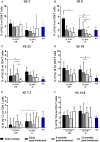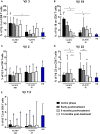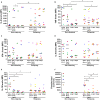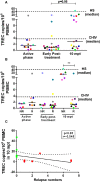Impaired Thymic Output Can Be Related to the Low Immune Reconstitution and T Cell Repertoire Disturbances in Relapsing Visceral Leishmaniasis Associated HIV/AIDS Patients
- PMID: 32508833
- PMCID: PMC7251171
- DOI: 10.3389/fimmu.2020.00953
Impaired Thymic Output Can Be Related to the Low Immune Reconstitution and T Cell Repertoire Disturbances in Relapsing Visceral Leishmaniasis Associated HIV/AIDS Patients
Abstract
Background: Visceral leishmaniasis/HIV-co-infected patients (VL/HIV) accounts for around 8% of VL reported cases in Brazil. Relapses of Leishmania infection after anti-leishmanial treatment constitute a great challenge in the clinical practice because of the disease severity and drug resistance. We have shown that non-relapsing-VL/HIV (NR-) evolved with increase of CD4+ T-cell counts and reduction of activated CD4+ and CD8+ T cells after anti-leishmanial treatment. This immune profile was not observed in relapsing-VL/HIV patients (R-), indicating a more severe immunological compromising degree. Elevated activation status may be related to a deficient immune reconstitution and could help to explain the frequent relapses in VL/HIV co-infection. Our aim was to evaluate if this gain of T cells was related to changes in the peripheral TCRVβ repertoire and inflammatory status, as well as the possible thymus involvement in the replenishment of these newly formed T lymphocytes. Methods: VL/HIV patients, grouped into non-relapsing (NR- = 6) and relapsing (R- = 12) were evaluated from the active phase up to 12 months post-treatment (mpt). HIV-infected patients (non-VL) and healthy subjects (HS) were included. The TCRVβ repertoire was evaluated ex vivo by flow cytometry, whereas the plasmatic cytokine levels were assessed by Luminex assay. To evaluate the thymic output, DNA was extracted from PBMCs for TCR rearrangement excision circles (TREC) quantification by qPCR. Results: VL/HIV cases presented an altered mobilization profile (expansions or retractions) of the TCRVβ families when compared to HS independent of the follow-up phase (p < 0.05). TCRVβ repertoire on CD4+ T-cells was more homogeneous in the NR-VL/HIV cases, but heterogeneous on CD8+ T-cells, since different Vβ-families were mobilized. NR-VL/HIV had the inflammatory pattern reduced after 6 mpt. Importantly, VL/HIV patients showed number of TREC copies lower than controls during all follow-up. An increase of recent thymic emigrants was observed in NR-VL/HIV individuals at 10 mpt compared to R- patients (p < 0.01), who maintained lower TREC contents than the HIV controls. Conclusions: VL/HIV patients that maintain the thymic function, thus generating new T-cells, seem able to replenish the T lymphocyte compartment with effector cells, then enabling parasite control.
Keywords: TCRVβ repertoire; immune response; relapses; thymic output; visceral leishmaniasis/HIV-1 co-infection.
Copyright © 2020 Silva-Freitas, Corrêa-Castro, Cota, Giacoia-Gripp, Rabello, Teixeira Dutra, Vasconcelos, Savino, Da-Cruz and Santos-Oliveira.
Figures





References
-
- Ministério da Saúde Situação Epidemiológica da Leishmaniose Visceral. Available online at: http://portalarquivos2.saude.gov.br/images/pdf/2019/janeiro/28/leishvisc... (accessed August 1, 2019).
-
- Fontoura IG, Barbosa DS, de Andrade Paes AM, Santos FS, Neto MS, Fontoura VM, et al. Epidemiological, clinical and laboratory aspects of human visceral leishmaniasis (HVL) associated with human immunodeficiency virus (HIV) co-infection: a systematic review. Parasitology. (2018) 145:1819 10.1017/S0031182018001166 - DOI - PubMed
Publication types
MeSH terms
Substances
LinkOut - more resources
Full Text Sources
Medical
Research Materials

